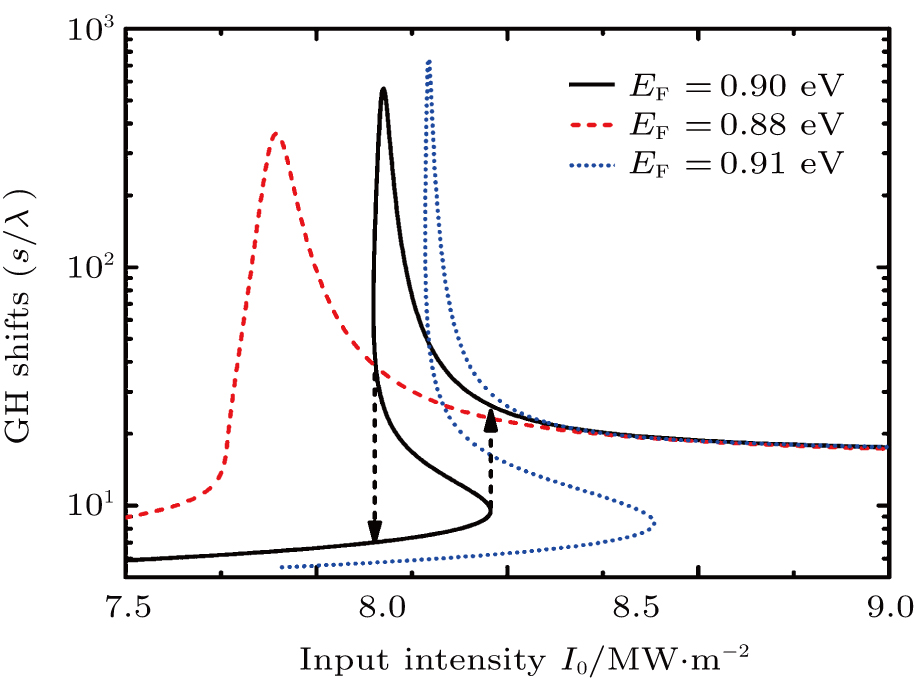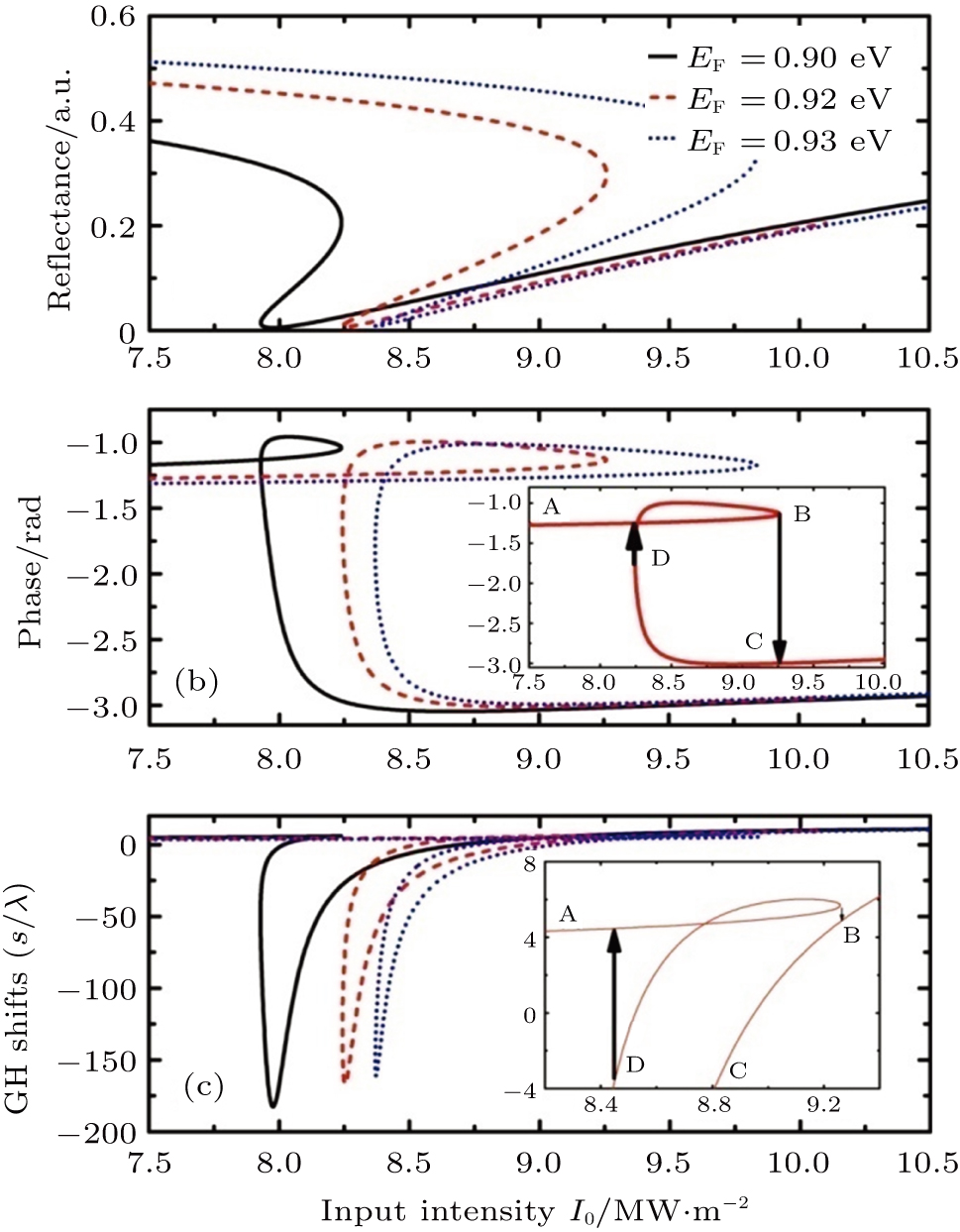† Corresponding author. E-mail:
Project supported by the National Natural Science Foundation of China (Grant No. 61505111).
The Goos–Hänchen (GH) shift of graphene in the terahertz frequency range is investigated, and an extremely high GH shift is obtained owing to the excitation of surface plasmon resonance in graphene in the modified Otto configuration. It is shown that the GH shift can be positive or negative, and can be enhanced by introducing a nonlinearity in the substrate. Large and bistable GH shifts are demonstrated to be due to the hysteretic behavior of the reflectance phase. The bistable GH shift can be manipulated by changing the thickness of the air gap and the Fermi level or relaxation time of graphene.
The Goos–Hänchen (GH) shift is usually a tiny lateral displacement from the prediction of geometrical optics when a light beam is reflected from an interface between media.[1–3] In the past twelve years, the GH shift has been widely discussed in various fields, such as optics,[4–7] chemistry,[8] and biomedicine.[9] The GH shift is usually studied at the interface of structures containing two homogeneous materials with different optical characteristics, and the magnitude of the shift is very small in this case, almost comparable to the wavelength of the incident beam.[10] Obtaining a large GH shift for better measurement, research, and application has become a hot topic of research. Owing to the noteworthy features of the amplified GH shift, it is often used in designing many devices such as optical switches,[11] polarizers,[12] lasers,[13] absorbers,[14] sensors,[9] and filters.[15]
Researchers have made great progress during the past few decades in studying how to increase the GH shift. For example, large positive and negative GH shifts can be obtained in waveguide structures owing to excitation of waveguide modes.[16] Further, when light is incident on left-handed materials, a large GH shift occurs owing to resonant excitation of surface vortexlike polaritons,[17] and external reflection of electromagnetic radiation in anisotropic crystals around its optical phonon frequencies causes a GH shift.[18] On the other hand, exciting surface plasmons (SPs) is another effective method to enhance the shift. When SPs are excited at a metal–dielectric interface, the electromagnetic fields near the interface become very strong,[19–23] which can lead to a huge shift. The largest lateral shift observed in experiments is almost 50 times the wavelength of the incident beam.[24] The method proposed by Chen et al.[25] using long-range surface plasmon resonance can increase the GH shift to 700λ (where λ is the wavelength of the incident beam), which is almost on the order of millimeters. Since then, SP excitation has been widely used to increase the GH shift.[26,27] To stimulate SPs, gold and silver are generally chosen as the best noble metal. However, there are still challenges involved in the use of traditional noble metals; for example, it is hard to tune the SP resonance owing to their strong stability, and the propagation distance of SPs is finite owing to the large loss, which limits their flexibility in future applications.
With the development of science and technology in recent years, a variety of new materials has emerged.[28–32] Graphene, as a new type of two-dimensional material, has attracted a great deal of attention owing to its extraordinary properties,[33–35] such as high electron mobility, low ohmic loss, high surface area, and adjustable Fermi energy level. Therefore, graphene is used to replace traditional metals to excite stronger SPs and to achieve a controllable GH shift by adjusting the Fermi levels.[36–38] In addition, because graphene can support p-polarized SPs at infrared and terahertz (THz) frequencies,[39] Farmani et al. were able to obtain the largest GH shift to date, 1089λ, in the THz range.[37]
With further research on graphene SPs, manipulation of the optical bistability (OB) has become a hot research topic because of the potential capabilities of controllable graphene SPs. OB occurs in a certain resonant optical structure, which depends on the history of the input light intensity; thus, there are two stable transmission states for a single input light intensity.[40] OB has become one of the most active research topics in nonlinear optics owing to its potential applications in optical memory,[41] optical transistors,[42] optical information processing,[43,44] and so on.[45,46] Although tunable GH shifts at THz wavelengths have been reported recently, there have been few reports of the bistable GH shift at THz wavelengths. Thus, in this article, we study the bistable behavior of the GH shift in the THz range; the proposed structure is based on the modified Otto configuration, where graphene covers a nonlinear substrate. We demonstrate that the GH shift can be manipulated by controlling the Fermi level and relaxation time of graphene or the thickness of the air gap. In particular, the GH shift can have positive or negative values and can be enhanced by introducing a nonlinearity in the substrate. The GH shift exhibits bistable behavior owing to the hysteretic behavior of the reflectance phase, which can be manipulated by changing the thickness of the air gap or the Fermi level or relaxation time of graphene.
A modified Otto configuration with highly doped graphene sheets is proposed to excite SPs, as shown in Fig.
Graphene is characterized by a complex surface conductivity σ.[47] In the THz range, intraband scattering is dominant in highly doped graphene; hence, σintra is sufficient to calculate the surface conductivity σ of graphene owing to the limit ωτ ≪ 1,
 |
 |
The reflection coefficient and transmission coefficients can be calculated using the Fresnel formula; however, owing to the nonlinear effects and the effect of graphene on the boundary conduction, the ordinary Fresnel formula should be modified at the interface between the air gap and the graphene covering the nonlinear dielectric. On the basis of our previous work,[49] r23 and t23 can be written as
 |
 |
 |

 |
 |
First, if the incident power is low, the nonlinearity of the substrate is not significant; hence, we can ignore the role of the nonlinearity in the GH shift, as shown in Fig.
Under strong light excitation, the nonlinear effects will become increasingly important. To obtain a very large nonlinear coefficient (
For EF = 0.90 eV, typical S-shaped curves appear for the dependence of the reflectance and the reflectance phase on the incident light intensity. These hysteresis phenomena indicate that two stable output powers can be obtained at a single given input power. As shown in Fig.
Owing to the strong dependence of the hysteretic effect on the graphene SPs, the optical properties of graphene will play an important role in the bistable behavior of the reflectance and reflectance phase. As we know, the optical conductivity of graphene depends on EF; hence, EF will play a large role in the hysteretic effect. As shown in Fig.
Figure
The bistability of the reflectance, reflectance phase, and GH shift also depend on the thickness d of the air gap, as shown in Fig.
In addition to depending on the Fermi energy, the GH shift is also affected by the electron–phonon relaxation time τ, as shown in Fig.
In summary, we analyzed the hysteretic response of the GH shift using a modified Otto configuration in which graphene sheets covered a nonlinear dielectric substrate. Our work demonstrated that large positive and negative GH shifts can be obtained by controlling the input light intensity owing to excitation of the graphene surface plasmon resonance. Moreover, we also demonstrated that the bistability of the GH shift depends on the properties of graphene (that is, the Fermi energy and relaxation time) and the thickness of the air gap. The tunability and large GH shift obtained using graphene could pave the way to all-optical switching, optical logic, optical memory, etc.
| [1] | |
| [2] | |
| [3] | |
| [4] | |
| [5] | |
| [6] | |
| [7] | |
| [8] | |
| [9] | |
| [10] | |
| [11] | |
| [12] | |
| [13] | |
| [14] | |
| [15] | |
| [16] | |
| [17] | |
| [18] | |
| [19] | |
| [20] | |
| [21] | |
| [22] | |
| [23] | |
| [24] | |
| [25] | |
| [26] | |
| [27] | |
| [28] | |
| [29] | |
| [30] | |
| [31] | |
| [32] | |
| [33] | |
| [34] | |
| [35] | |
| [36] | |
| [37] | |
| [38] | |
| [39] | |
| [40] | |
| [41] | |
| [42] | |
| [43] | |
| [44] | |
| [45] | |
| [46] | |
| [47] | |
| [48] | |
| [49] | |
| [50] |







